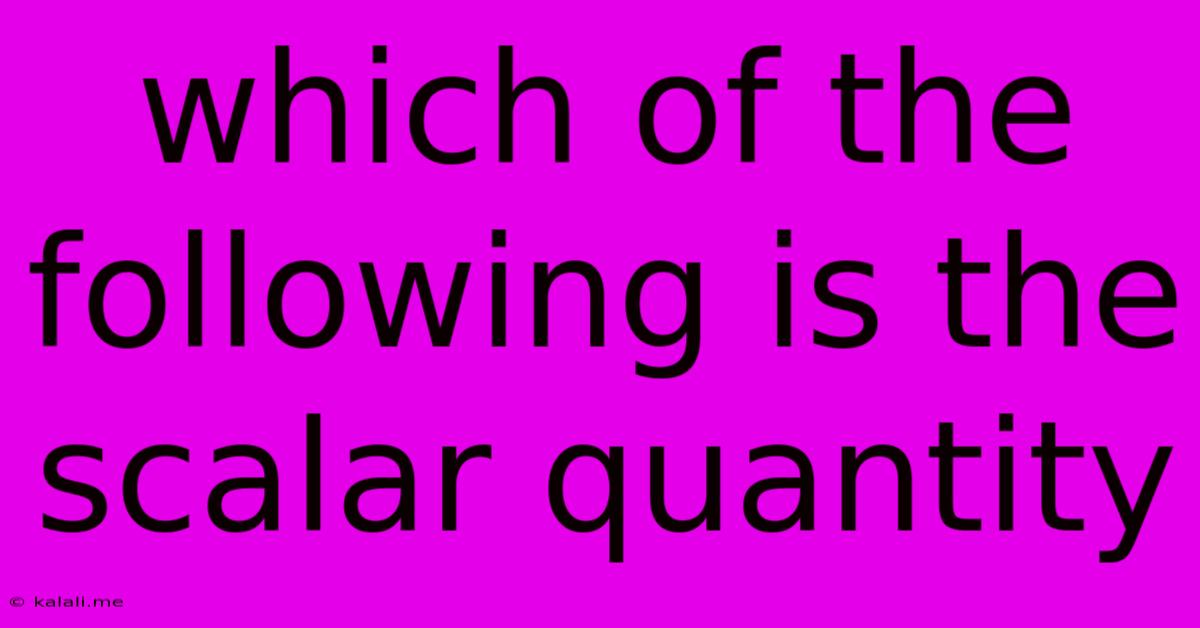Which Of The Following Is The Scalar Quantity
Kalali
Jun 11, 2025 · 2 min read

Table of Contents
Which of the Following is the Scalar Quantity? Understanding Scalars and Vectors
This article will delve into the fundamental difference between scalar and vector quantities, ultimately answering the question: which of the following is the scalar quantity? We'll explore what defines each type of quantity and provide clear examples to solidify your understanding. This will help you confidently identify scalar quantities in various physics and mathematical problems.
What are Scalar Quantities?
Scalar quantities are those that possess only magnitude – a numerical value. They are fully described by a single number and do not have a direction associated with them. Think of it as simply a measurement without any indication of where it's pointing.
Examples of Scalar Quantities:
- Mass: The amount of matter in an object (e.g., 5 kg).
- Speed: The rate at which an object covers distance (e.g., 60 mph). Note the difference between speed and velocity, which is a vector.
- Temperature: A measure of how hot or cold something is (e.g., 25°C).
- Energy: The capacity to do work (e.g., 100 Joules).
- Time: The duration of an event (e.g., 2 hours).
- Volume: The amount of space occupied by an object (e.g., 10 liters).
- Density: Mass per unit volume (e.g., 1 g/cm³).
- Distance: The total length of the path covered (e.g., 10 km). Note that distance is a scalar, whereas displacement is a vector.
What are Vector Quantities?
Unlike scalar quantities, vector quantities possess both magnitude and direction. They require both a numerical value and an indication of the direction in which that value acts.
Examples of Vector Quantities:
- Displacement: The change in position of an object (e.g., 5 meters east).
- Velocity: The rate of change of displacement (e.g., 20 m/s north).
- Acceleration: The rate of change of velocity (e.g., 9.8 m/s² downwards).
- Force: A push or pull acting on an object (e.g., 10 N upwards).
- Momentum: The product of mass and velocity (e.g., 20 kg m/s east).
Identifying Scalar Quantities: A Practical Approach
To determine whether a quantity is scalar, ask yourself: Can it be fully described by a single number? If the answer is yes, and no direction is needed to understand it, then it's a scalar quantity.
Conclusion:
Understanding the difference between scalar and vector quantities is crucial in physics and various other scientific fields. While this article provides a comprehensive overview, remember that the key distinction lies in the presence or absence of direction. By applying the principles outlined above, you can accurately identify scalar quantities from a given set of options. Keep practicing and you'll master the difference between these important physical quantities.
Latest Posts
Latest Posts
-
How Many Feet Is Half An Acre
Jul 01, 2025
-
If I Was Born In 2004 How Old Am I
Jul 01, 2025
-
How Long Would It Take To Drive 2000 Miles
Jul 01, 2025
-
What Color Does Black And Blue Make
Jul 01, 2025
-
How To Pass Level 7 In Bloxorz
Jul 01, 2025
Related Post
Thank you for visiting our website which covers about Which Of The Following Is The Scalar Quantity . We hope the information provided has been useful to you. Feel free to contact us if you have any questions or need further assistance. See you next time and don't miss to bookmark.